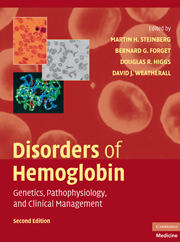Book contents
- Frontmatter
- Contents
- List of Contributors
- Foreword, by H. Franklin Bunn
- Preface
- Introduction, by David J. Weatherall
- SECTION ONE THE MOLECULAR, CELLULAR, AND GENETIC BASIS OF HEMOGLOBIN DISORDERS
- SECTION TWO PATHOPHYSIOLOGY OF HEMOGLOBIN AND ITS DISORDERS
- 8 Rheology and Vascular Pathobiology in Sickle Cell Disease and Thalassemia
- 9 The Erythrocyte Membrane
- 10 The Biology of Vascular Nitric Oxide
- 11 Mechanisms and Clinical Complications of Hemolysis in Sickle Cell Disease and Thalassemia
- 12 Animal Models of Hemoglobinopathies and Thalassemia
- SECTION THREE α THALASSEMIA
- SECTION FOUR THE β THALASSEMIAS
- SECTION FIVE SICKLE CELL DISEASE
- SECTION SIX OTHER CLINICALLY IMPORTANT DISORDERS OF HEMOGLOBIN
- SECTION SEVEN SPECIAL TOPICS IN HEMOGLOBINOPATHIES
- SECTION EIGHT NEW APPROACHES TO THE TREATMENT OF HEMOGLOBINOPATHIES AND THALASSEMIA
- Index
- Plate section
- References
8 - Rheology and Vascular Pathobiology in Sickle Cell Disease and Thalassemia
from SECTION TWO - PATHOPHYSIOLOGY OF HEMOGLOBIN AND ITS DISORDERS
Published online by Cambridge University Press: 03 May 2010
- Frontmatter
- Contents
- List of Contributors
- Foreword, by H. Franklin Bunn
- Preface
- Introduction, by David J. Weatherall
- SECTION ONE THE MOLECULAR, CELLULAR, AND GENETIC BASIS OF HEMOGLOBIN DISORDERS
- SECTION TWO PATHOPHYSIOLOGY OF HEMOGLOBIN AND ITS DISORDERS
- 8 Rheology and Vascular Pathobiology in Sickle Cell Disease and Thalassemia
- 9 The Erythrocyte Membrane
- 10 The Biology of Vascular Nitric Oxide
- 11 Mechanisms and Clinical Complications of Hemolysis in Sickle Cell Disease and Thalassemia
- 12 Animal Models of Hemoglobinopathies and Thalassemia
- SECTION THREE α THALASSEMIA
- SECTION FOUR THE β THALASSEMIAS
- SECTION FIVE SICKLE CELL DISEASE
- SECTION SIX OTHER CLINICALLY IMPORTANT DISORDERS OF HEMOGLOBIN
- SECTION SEVEN SPECIAL TOPICS IN HEMOGLOBINOPATHIES
- SECTION EIGHT NEW APPROACHES TO THE TREATMENT OF HEMOGLOBINOPATHIES AND THALASSEMIA
- Index
- Plate section
- References
Summary
INTRODUCTION
Oxygen delivery and metabolite transfer occur in the exchange compartment of the microcirculation, processes affected by erythrocyte abnormalities and alterations in components of the vascular wall, with the latter influencing flow regulation at the arteriolar level. In sickle cell disease and thalassemia, red cell rheology is abnormal; there is hemolysis, anemia, and red cell and tissue oxidative stress. Chronic hypoxia and hemolysis, common to both conditions, necessitate vascular tone and flow adaptations. In sickle cell disease, red cell deformability is sensitive to intravascular O2 tension as deoxygenation results in hemoglobin S (HbS) polymerization, erythrocyte sickling, and vasoocclusion. Vasoocclusive events in sickle cell disease result in reperfusion injury characterized by excessive oxidant generation, endothelial activation and dysfunction, and inflammation. Similarly, in thalassemia, red cell abnormalities caused by precipitation of excess globin chains and oxidative stress lead to hemolysis and reduced red cell deformability and contribute to vascular pathobiology. Therefore, the heterozygote advantage seen in carriers of both these diseases (Chapter 26) is balanced by the vasculopathy characteristic of the homozygote. This chapter addresses the role of blood components and other factors that contribute to the vascular pathobiology of sickle cell disease and thalassemia.
SICKLE CELL DISEASE
Red Cell Rheology
Red cell rheology is the study of the cellular deformation under shear forces as encountered in the blood circulation. Pliability, or deformability, is a prominent feature of normal red cells, which enables them to traverse the microcirculation. The average diameter of normal human erythrocytes is approximately 8 μm.
- Type
- Chapter
- Information
- Disorders of HemoglobinGenetics, Pathophysiology, and Clinical Management, pp. 139 - 157Publisher: Cambridge University PressPrint publication year: 2009
References
- 1
- Cited by



